Lupin III: The Castle of Cagliostro (ルパン三世 カリオストロの城 , Rupan Sansei: Kariosutoro no Shiro lit. Lupin the Third: Castle of Cagliostro) is an animated film co-written and directed by Hayao Miyazaki that premiered on December 15, 1979.
The second animated Lupin III movie and arguably the most famous, it was written and directed by Hayao Miyazaki (who also co-directed Lupin the Third Part I and directed two episodes of the second series) before he formed Studio Ghibli. Cagliostro features gentleman thief Lupin III, grandson to Maurice Leblanc's French literary master thief Arsène Lupin. The title alludes to La Comtesse de Cagliostro (The Countess of Cagliostro, the title of an original Arsène Lupin adventure by Maurice Leblanc).
It was originally subtitled by Metro-Goldwyn-Mayer and then dubbed and released in 1991 by Streamline Pictures. A new dub was recorded by Manga Entertainment in 2000, which changed the tone of many of the characters. A digitally remastered version was then released by Toho Imaging Division in 2014. On January 20, 2017, the MX4D version based on the digitally remastered version was screened for a limited time for the 50th anniversary of Lupin III. From November 8 to 21, 2019, the Lupin III: The Castle of Cagliostro [4D version] was screened to commemorate the 40th anniversary of its theatrical release.
On October 25 and 26, 2019, Yuji Ohno performed for the 40th Anniversary of the Movie Release & 55th Anniversary of the Yuji Ohno Musical Activity Official Project ~ Movie, Lupin III: The Castle of Cagliostro Cinema Concert! and the best hits of Lupin III" LIVE!.[1] A video game adaptation was released by Asmik Ace on January 10, 1997.
Advertising Catchphrases[]
- "There is no point in making a second work if you can not surpass the previous work." (前作をしのげないのなら 2作目を作る意味がない)
- "A huge castle begins to move! A shadow army attacks!" (巨大な城が動き始める! 影の軍団が襲ってくる!)
- "Faster! More thrilling! It's a blur!" (さらにスピーディーに! さらにスリリングに! さらにスッとボケて!)
- "The strongest enemy I finally met in a mysterious old castle that can't return to life!" (生きては還れぬ謎の古城でついにめぐり逢った最強の敵)
Overview[]
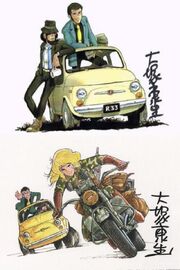
Lupin III illustration by Yasuo Ōtsuka.
The Castle of Cagliostro follows gentleman thief Arsène Lupin III, who successfully robs a casino – only to find the money to be counterfeit. He heads to the tiny country of Cagliostro, the rumored source of the bills, and attempts to save the runaway Clarisse from the Count Cagliostro's men. Lupin enlists his associates, Jigen and Goemon, and sends his calling card to the Count to get Inspector Zenigata, his longtime nemesis, to the castle. After becoming trapped in the dungeon under the castle, Lupin and Zenigata form a pact to escape and foil the Count's counterfeit operation and save Clarisse from her forced marriage to the Count.
The original theatrical release in Japan occurred on December 15, 1979. The American theatrical debut was on April 3, 1991, with the home release following in October 1992. This first dub was produced by Streamline Pictures and released on home video the following year. A new dubbed version was produced by Manga Entertainment in 2000 and has had several releases.
Despite initially underperforming at the box office, The Castle of Cagliostro has garnered high praise, with critics and historians noting the film's influence on Miyazaki's later works, and has since become the most popular and well-regarded entry in the entire Lupin III franchise. However, some viewers, including Monkey Punch himself, disapproved of its depiction of Lupin as a gallant hero instead of his original ruthless criminal self. The film has also served as a major influence on animators and directors worldwide, most notably Pixar director John Lasseter.
Plot[]
Principality of Cagliostro[]
"I've never heard of the Duchy of Cagliostro."
"With a population of 3,500, it's the smallest nation in the world to be a member of the U.N."
"And that's the source of the Goat Money?"
"There's a notorious legend about it, according to those in the know. They call it "The Black Hole of the Counterfeit World."
"Black Hole?"
"They say that no one has gotten close to it and returned to tell about it."
"Well, _I'm_ sure scared. I'm so scared, in fact, that I'm gonna catch some Zs."

Lupin III, Jigen and Goemon flee the police.
The year is 1968. Arsene Lupin III, Daisuke Jigen and Goemon are escaping on a Fiat 500 pursuit after robbing the casino of Monaco, only to discover that their entire haul is counterfeit. When Lupin was just getting started as a professional thief, he was almost killed while searching for the source of these so-called goat bills. He decides that it is time to take another chance, and, with Jigen, heads off to the purported source of the bills, the Principality of Cagliostro.
Shortly after arriving, they rescue a young girl from a car full of thugs, only to let her get captured again when Lupin is knocked unconscious after tumbling down a cliff. They later discover that she is Clarisse, the princess of Cagliostro and is engaged to be married to the Count Cagliostro, the country's ruler. The count wants to recover the ancient treasure of the Cagliostro family, and needs the princess's ring to do so.
Mystery Unfolds[]
"Tell me where the exit is. How did you get here?"
"I was dropped down here too. Judging by the way you look, I'd say you've been doing quite a bit of walking around down here. Am I right?"
"Shut up! I won't take pity from a thief!"
"Well, let's take it easy, seeing as how there's no way out... Excuse me a moment. Hey give me a light, Old Man."
"Lupin, just what the hell is it with all these corpses? This is no burial ground."
"Take a look at that wall."
"Why--this is...Rest in peace! Rest in peace! I didn't think this was your run-of-the-mill castle, but what secret would they go to these lengths to protect? Hey! Is this what you're after too?"
"That's what Fujiko's doing. I hope she doesn't become a corpse. Anyway, it's no use to start wasting our energy. Good night, Old Man."

Lupin III goes against the evil Count and his plot to marry his niece.
Realizing he will need more help after he is attacked by a group of the count's elite assassins, Lupin calls on Goemon and tips off longtime foe Inspector Koichi Zenigata to his whereabouts. He also find his former lover, Fujiko Mine, posing as Clarisse's lady-in-waiting. Using a party and Zenigata as a distraction, Lupin makes his way to the tower where Clarisse is kept, returns her ring, and promises to help her to escape. The count arrives shortly thereafter with his assassins; Lupin is dropped down a trapdoor into the bowels of the castle.

The Count and his deadly henchman.
The ring turns out to be a practical joke left by Lupin. Infuriated, the Count flushes him deeper into the cellars, which are full of bodies of spies who attempted to learn the secrets of Cagliostro and the goat bills. While down there, Lupin bumps into Inspector Zenigata, who was accidentally thrown down earlier. The two reluctantly form a pact to help escape. Using two aqualungs dropped by elite soldiers, the pair escape.
Their escape leads them to the printing presses, where Lupin and Zenigata finally discover the source of the goat bills. Zenigata wants to find evidence, but Lupin points out they must escape first. They set the money and presses on fire as a distraction and steal the count's autogyro. However, when they attempt to return to rescue Clarisse, Lupin is shot and critically wounded. Clarisse offers her ring to the count in exchange for Lupin's life; the count's attempt at betrayal is foiled when Zenigata arrives in the burning autogyro, and Fujiko grabs Lupin and escapes with the Inspector. The Count tries to shoot at them, but Clarisse stops him.
Lupin Returns[]
"A Roman city was lying at the bottom of the lake."
"When the Romans were chased away from the site, they built a lock and sunk it, and your ancestors claimed it in secret. It's really a treasure for mankind. Certainly too big for my pockets. Interpol finally decided to do something."
"Will you be going now?"
"Since all the old men have come, yes."
"Take me with you. I can't be a thief yet, but I'll learn. Please...take me! I want to go with you."
"Clarisse... Don't talk stupid. Do you want to go back into the darkness again? You've come out into the sun at last. Hey--your life begins now. Don't become filthy like me--I'll tell you what! If you're ever in trouble, I'll fly straight to you no matter when, even if I'm on the other side of the world."

Lupin III and Clarisse finally uncover the mystery of the Cagliostro legacy.
The wedding appears to go on as planned with a drugged Clarisse until Lupin's "ghost" disrupts the ceremony. When the count calls down his guards, Lupin manages to make off with Clarisse and both rings. Lupin and Clarisse flee the count, a chase that ends on top of the castle clock tower. Finally gaining the rings after knocking away Lupin and Clarisse, the count uses them on the clock tower's face as instructed by Lupin, only to be crushed to death by the clocks hands as the mechanisms move to unveil the treasure.
Lupin and Clarisse, who have safely landed in the lake, watch the lake around the castle drains to reveal exquisite ruins. Lupin and his friends take their leave of Clarisse, now ruler of Cagliostro, as Zenigata chases after them again and Fujiko makes off with the printing plates from the counterfeit money presses.
Characters[]
- Arsene Lupin III (ルパン三世(ルパンさんせい)
- The greatest gentleman thief in the world. Lupin (he is never called by his first name) is extremely intelligent and charismatic. He steals things, ranging from bags of cash to golden treasures, for the thrill of it, instead of actually needing the things he steals, and he never steals from the poor. He flirts often, usually with strangers, although he respects Clarisse. He has many associates, including Jigen, Goemon, and, to a smaller extent, Fujiko. He's a little older now, and regrets his wild and turbulent past.
- Fujiko Mine (峰 不二子(みね ふじこ)
- A self-described “lady spy” who often steals the very thing Lupin is after. Lupin practically worships Fujiko, but she only returns the affection if it helps her accomplish her goals. She treats everyone with respect and usually ends up helping Lupin in some way. She is very tough, having held off squads of goons with a machine gun and grenades.
- Daisuke Jigen (次元 大介(じげん だいすけ)
- A superb marksman who travels with Lupin. Jigen works with Lupin on many of his heists, lending his almost uncanny ability with all sorts of guns to fight against the people who try to stop them. Jigen is Lupin’s partner, not his inferior.
- Ishikawa Goemon XIII (石川 五ェ門(いしかわ ごえもん)
- A samurai who works with Lupin. Goemon is a master swordsman. He is quiet and doesn’t speak unless it’s important. He wears Japanese clothes and eats Japanese food. He can use his sword to cut through anything; from body armor to bullets. He often covers Lupin during one of his schemes.
- Koichi Zenigata (銭形 幸一(ぜにがた こういち)
- An inspector for INTERPOL. Inspector Zenigata is given many assignments, but he is chasing one criminal with much more enthusiasm than the others: Lupin. He isn’t stupid, but he is always outwitted by Lupin’s more clever plans. Lupin describes Zenigata as “the archetypical Japanese worker: totally dedicated to his work”. Zenigata has a small army of INTERPOL officers working for him who idolize him and do whatever he asks them to do.
- Count of Cagliostro (カリオストロ伯爵(グラフ・ラザール・ド・カリオストロ)
- The regent of the small country of Cagliostro. The Count is a very rich man, but he desires even more riches; specifically, the treasure of the Cagliostro family. He is cruel and cunning, and will use all of his considerable resources to get what he wants. He lives in an enormous castle in the middle of Cagliostro, surrounded by a lake.
- Clarisse d'Cagliostro (クラリス・ド・カリオストロ)
- A princess of the Cagliostro family. Clarisse is kind to everyone and admired by many of Cagliostro’s citizens. She is engaged to be married to Count Cagliostro against her will, since their marriage will enable the Count to claim the fortune of the Cagliostro family.
Jodot (ジョド)
Count Cagliostro's loyal but somewhat inept butler. He leads the Count's secret team of assassins.
Gustav (グスタフ)
The head of Count Cagliostro's squad of "gendarmes".
Gardener
The old gardener of Clarisse's family who works on the castle grounds. He looked after Clarisse's dog Karl after she was sent away to the monastery.
Source Material[]
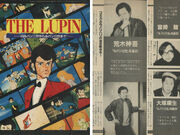
The June 1982 special THE LUPIN: From Former Lupin III to Lupin VIII, featuring Yasuo Ōtsuka and Hayao Miyazaki.
Lupin III began as a Japanese manga series written and illustrated by Monkey Punch. The title character, Arsène Lupin III, was inspired by (and is claimed in the series to be the grandson of) Maurice Leblanc's fictional character Arsène Lupin, a gallant and famous outlaw able to outsmart even Sherlock Holmes. Lupin III is a gentleman thief and announces his intentions to steal valuable objects by sending a calling card to the owners of the desired items. The manga's popularity led to two anime series, titled Lupin the Third Part I and Lupin III Part II. The first film, The Mystery of Mamo, was released on 16 December 1978. Cagliostro followed the year later following the financial success of that film.
Reinventing Lupin[]
This is marked as the first feature length film to be directed by Hayao Miyazaki, who had previously co-directed episodes of the first Lupin anime series with Isao Takahata and the two directors along with Toshio Suzuki will give birth to Studio Ghibli in 1985. He was also a writer and director of two episodes in the second series under the pseudonym Telecom, both produced a year after Cagliostro. In works other than Castle of Cagliostro and the series episodes directed by Miyazaki and Takahata, Lupin III is portrayed as a scheming and lecherous thief, sometimes supported by his former enemies Jigen and Goemon. Miyazaki's film conflicts with the typical behavior and personality of the characters, a change that has been described as Lupin "growing up".
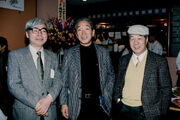
From the left, Hayao Miyazaki, the late Daikichirou Kusube (Shin-Ei Animation Chairman, former President of A Pro) and Yasuo Ōtsuka.
In a 1981 interview, Miyazaki explained his vision of Lupin, "To be honest, when I was first asked to join, I thought “why now?” For me, and I think Otsuka-san feels much the same, but Lupin was a character living in 60s to 70s. So I thought the theme to use Lupin was bit old and dated."
"Even the original comic book, I heard that Monkey Punch spent a lot of effort on this because he wanted to make his name big in comic industry as a new comer. So it was interesting. I liked the energy of this comic. Beyond his drawing sense, I felt the overwhelming energy and hungry spirit from the author. That is why Lupin the Third himself got much of the same characteristics: the hungry spirit. He was not a cool, unaffected fellow. I believe he was a reflection of Monkey Punch himself back then. We found ourselves in common with his hungry spirit as anime creators. So as we created the animation, we felt these characters to be so similar and close to us, even when I first read the comic I felt so. Although the first TV series was not commercially successful, we felt that we had a lot of fun and did what we wanted to do…"

Miyazaki wanted to shake up Monkey Punch's Lupin III formula and return the series to its bare basics.
"Anyway, then after the first TV series comes the second, and then the movie (The Mystery of Mamo). I felt that Lupin had seen all the glory and ended all its chapters. So I was quite astonished when they were starting up again."
"I questioned myself. What do I want to do with it now? For what kind of audience? Maybe I am being over melodramatic about it, but I did not know what I was doing this all for. Of course, there were some materials and motifs which I always had in mind, but I had to rethink of the character “Lupin” all over again, who he is, what he is."
"First of all, the structure of Lupin is a very loose one. There is no “unchangeable/untouchable image of Lupin the Third” which we are bound to. It can take anything. We can throw anything at it. It encompasses anything and everything. So as Otsuka-san said, there are lots of different interpretations. If there are 100 people (viewer or creator, he did not specify), there are 100 different Lupin exists as well. And when opportunity came around and I had to create my version of Lupin, all I could think was the image of Lupin lived in his glory in 60s and early 70s, now living in the regret and shame for his young and wild life."
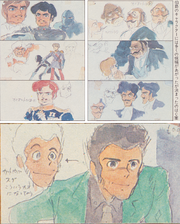
Early concept sketches of Lupin III seem to indicate a more mature looking Lupin III, along with alternate designs for Count Cagliostro.
"So even the selections of cars in the film, I did not make them too contemporary. I did not want to go too antique either, but I limited the selection of cars from 50s and 60s. A torpedo boat seems bit too outdated, however, I was trying not to show motorboat or anything new of that sort to keep the tone of the film. It was rather a fashion statement and approach when determining the design of the animation."
"Then I thought this Lupin was probably a kind of man who used to drove Mercedes Benz SSK but now he is out of that phase and bored with it. He realized, after all, it does not matter what car he drives, as long as it drives, and he is just driving around with the most basic car. He is over the fame and status which came with the money. He is no longer a man who would pull out the most rare and expensive cigarette lighter to light his cigarette anymore. He does not give a single damn about such thing. He is fine with the cheap disposable one as long as it does the job. That was my image of Lupin. I felt like I finally understood Lupin. And based on that image, I created this film."
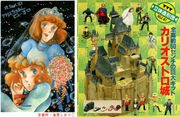
Animage fan art page of Clarisse from the December 1982 issue, and a mini-Castle of Cagliostro figure from the October 1992 issue.
"I think that underlying philosophy was displayed and carried throughout this film. For example, he is using a disposable lighter to light his cigar and eating instant cup noodle. He is returned to the basics. Recently, there is a trend which people wear designer brand closes and items, but he is the one who would see it all from outside and thinking “it is only country bumpkins who would do that.” He stopped caring about those fashion and status ten years ago. The same goes for his comrades."
"Even when it comes to love, he keeps the same stance. Maybe if it was ten years ago, he would have fallen for love, but now he knows he is not that young nor innocent, so he excuse himself as “old man” and draw the line. [laughs]"
I felt that popular image of Lupin was very close to the players/hustlers who would hang around in Casinos. To me, that did not seem cool. That would be more close to, let’s say the politicians going to Las Vegas for vacations? (probably 80’s reference for expensive vacations or show offs) It is unsophisticated/unrefined and shows that they have no class. But Lupin stopped aspiring to be rich one day."[2]
Behind the Scenes[]
Development[]
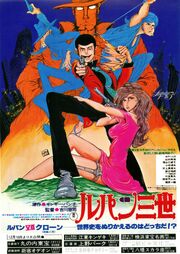
The poster for 1978's The Mystery of Mamo, the first Lupin III movie.
Castle of Cagliostro marked Miyazaki's debut as a theatrical movie director, but he also was a writer, a designer, and a storyboardist on the movie. He considered it as "a big sketch / rough picture of what he did in the Lupin III series and Toei animation era". At first, Tokyo Movie Shinsha (now known as TMS Entertainment) had asked Yasuo Ōtsuka to direct the screenplay written by Seisun Suzuki and other screenwriters of Lupin the Third Part II and the film The Mystery of Mamo, but Ōtsuka, who was not willing to do so, asked Hayao Miyazaki to take over as director. At the time, Miyazaki was in charge of the layout and scene setting of Anne of Green Gables with Isao Takahata, but he dropped out and began preparing for Cagliostro's production in early 1979. Ōtsuka would serve as Animation Director.
In a 1981 interview with Ōtsuka, he explains, "First off, back then, it was as if Miya-san (Hayao Miyazaki) faced a proposition to create what kind of Lupin you would come up with including its title 'Castle of Cagliostro.' What I mean by that is, by then, Lupin and its world had many interpretations including the TV series which I created 10 years ago and later on the first movie (Legend of Mamo) was already out when we started discussing the plan for this next film. Of course there was also Monkey (Punch) -san’s original comic to base all of it off. Even in his comic, there is a world of differences compared to when he first started it and now."
"So there was a basic premise that Lupin can be interpreted in many different ways, then we started discussing “how we should draw it this time” for this next film piece. In the actual timeline it was May of 1979 that I asked Miya-san to join. The rest of the plan was completely blank; we supposed that we could start working on the drawings/sketches in maybe from July. So we had two months for Miya-san to develop this Lupin, what kind of element he would add and how he would put them together to make it a story of Lupin. Then we spent next four months creating the actual film. That was how this film piece was made. As a result, this film became pretty intense and enriched in flavor."
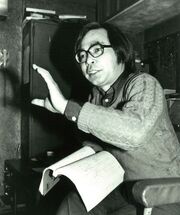
The 1979 film would be Hayao Miyazaki's directorial debut.
Production for the film began in May 1979 with the writing of the story and storyboarding for the film. Miyazaki, who often works without a completed script, began by drawing a bird's eye view of the setting before creating the story to completion. After the first draft scenario was returned to Miyazaki without change, he began the storyboards. At the time, the screenplay had been co-written with Haruya Yamazaki, but evidence shows Miyazaki ignoring Yamazaki's ideas and changing the story completely. The novelization published by Shueisha Cobalt Bunko features much of the original screenplay Yamazaki.
Miyazaki elaborates on how animation makes Lupin stand out in animation, "In the case of Lupin, he is a thief. So he makes his living off of stealing things from the ordinary and normal people who make their living in legally proper way. It is bound to reality. The more we draw the ordinary people, the more the unusualness of a thief can stand out and shine. If we wander off and draw a preposterous world and people instead too much, the novelty and shock value of a thief would disappear."
"So we first have to create and establish a quite decent, ordinary part in the film. If we focus too much on the lolita complex, abnormal love story or rely too much on some extraordinary gadgets inventions, Lupin’s charm as a thief would become bleak. First and foremost, he needs to solve the difficult situations with his own mind and body. Even when he is using a gadgets, it has to be something he might come up with and invented himself. Otherwise he would not be a thief. The whole film itself would be a Sci-fi. Who would like to watch a James Bond who went to outer space? It would be so boring. He would be dressed in space suits and cannot even make out with a girl that easily, you know? [laughs]"
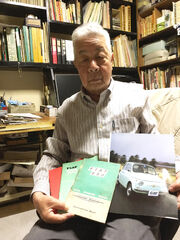
The late Animation Director and Jeep / vehicle enthusiast Yasuo Ōtsuka.
"Even when drawing the mechanical items, such as cars, planes, tanks and battleships, the engineers invented them all. They are the designers. I would not give any credits to the animators who simply drew them well on the screen. I think it is very important to keep in mind, that the animators should be focused on how to use those items in his animation rather than just sketching the item to perfection."
"If Fiat 500 comes out on the screen and moves exactly how a real Fiat 500 would move, then it is pointless. Then it would be just showing a fashion statement of the creator that he likes this car over any other car. But if that Fiat 500 moves like a certain character and his mood, it would be a character on its own. So no matter how broken it may appears, how many window panels its missing, as long as it does its best, it is fine and charming, I think. I wonder how boring it would have been if we picked a brand new supercar for the speed car chase scene at the beginning of the film."
Production[]
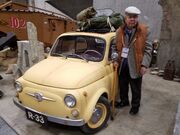
The late Yasuo Ōtsuka beside a replica of Lupin III's Fiat 500.
The story was divided into four parts, but after reaching the third part changes had to be made at the storyboard phase in order to not exceed the decided running time. Animation work began in July 1979 while the storyboards were only a quarter complete; Miyazaki had to complete them during the animation production. Originally, Ōtsuka was the Animation Director of Lupin the Third Part I, and both Miyazaki and Takahata were responsible for directing the second half of the first series of TV. For this reason, the film utilizes characters, props, and image boards designed by Miyazaki and Ōtsuka taken from Part I. Additionally, Lupin wore a red jacket in series Part II and Mystery of Mamo, but for Caligiostro, he wears a blue-green jacket which he wore in Part I, and his car is not Alpha Romeo as seen in Part II, but a Fiat 500 that first appeared in the second half of Part I.
During recording, MIyazaki asked Yasuo Yamada to be more subdued, "like Clint Eastwood". Yamada retorted, "Leave Lupin to me!", and insisted that he do whatever he want with the character. Miyazaki was incensed by Yamada and his arrogant attitude. Character designer Yasuo Otsuka advised Miyazaki, "Yasuo is being cheeky, so let's take it down a bit." After watching the finished product, Yamada sincerely apologized to Miyazaki.
Production wrapped up at the end of November and the film's premier on December 15, 1979 was a short seven and a half months from the project's undertaking, with only five months of production time. Fearing he would miss the deadline, Miyazaki remarked, "I first learned the limits of my physical strength with this work."
Director's Influences[]

Paul Grimault's The King and the Mockingbird as it was released in 1980, but it began in 1948 as The Shepherdess and the Chimney Sweep
The film draws upon many sources of inspiration that were important in the production of the film. McCarthy writes that a research trip was not specifically undertaken for the film, but says Miyazaki's Heidi sketchbooks were useful for the scenery. Miyazaki would cite Italian Mountain Cities and the Tiber Estuary from Kagoshima Publishing as influencing the production of the film. The film included elements that were seen in other Arsène Lupin works, including La Justice d'Arsène Lupin by Boileau-Narcejac, involving the discovery of a tremendous stash of forged franc notes with which World War I–era Germany had planned to destabilize the French economy. Maurice Leblanc's The Green-eyed Lady also featured a secret treasure hidden at the bottom of a lake.
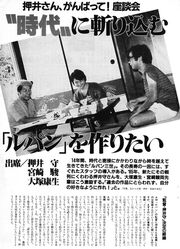
Mamoru Oshii’s Lupin III movie project: An interview with Yasuo Ōtsuka, Mamoru Oshii and Hayao Miyazaki on Animage's October 1984 issue.
The castle is visually influenced by that of the original 1952 unfinished release of The Shepherdess and the Chimney Sweep. Greenberg writes, "Cagliostro also borrowed many narrative and visual elements from Grimault's film: the basic plotline of disrupting the wedding of an evil tyrant and a beautiful innocent girl, the tyrant's luxuriously-decorated palace that is also full of traps, and a gang of henchmen serving the tyrant – both oversized goons and ninja-like assassins..." The staff added personal touches to the film, the most iconic being Lupin's car, the Fiat 500, was the car of head animator Yasuo Ōtsuka. Clarisse's car in the chase scene is a Citroen 2CV, which is Miyazaki's first car.
McCarthy describes the summery color palette of the film as matching the scenery and the characters, but notes the use of dark and light colors are used to emphasize the subplot of the dark and light sides of the Cagliostros. The film's score was composed by series regular Yuji Ohno, and varies between jazz, romance and orchestral music. Notably, it includes a variation of Lupin III's iconic TV theme. The music was performed by You & The Explosion Band, who had previously worked on the second television series. The main vocal song Fire Treasure was performed by Bobby (aka Toshie Kihara) and saw release as an LP single. The first release of the soundtrack was Lupin the 3rd The Castle of Cagliostro Original Soundtrack BGM Collection, an album containing extended versions of select cues from the film. It was originally sold on vinyl and cassette tape in 1983, but later saw release on CD in 1985 with several additional prints runs. In 2003, the entire score was finally released on a newly commissioned album entitled Lupin the 3rd: The Castle of Cagliostro – Music File and also contained 13 unused cues.
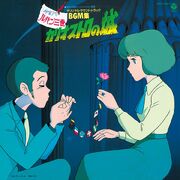
Cover art for the Lupin III The Castle of Cagliostro Original Soundtrack BGM Collection.
Castle of Cagliostro's portrayal of the characters was changed to better identify with Miyazaki's concept of a "hero" and to remove a sense of apathy in the story. This resulted in Lupin being a happy-go-lucky and upbeat thief who drives and lives out of a Fiat 500; a sharp contrast to the scheming and lecherous Lupin who drives expensive cars like the Mercedes-Benz SSK because it was "Hitler's favorite". The changes would also impact secondary characters like Jigen and Goemon, changing their serious and cold personalities into friendly and humorous; even the erotic elements involving the femme-fatale Fujiko were dropped.
Sequel[]
Miyazaki was first tapped as director for a third Lupin III movie, but declined and instead recommended his friend Mamoru Oshii. Unfortunately, Oshii left the production and although the film, Lupin III: Legend of the Gold of Babylon was still completed, it did so with a completely different story and staff.
Localization[]
Fred Patten, who worked at Streamline Pictures was involved in the English adaptation of the film and was involved in the choice of title for the English release,
The Japanese title is Lupin III: Cagliostro no Shiro, which is literally Lupin III: Cagliostro of Castle [sic].[b] So which would be better in English; Cagliostro Castle, Cagliostro's Castle, or The Castle of Cagliostro? It was my argument that The Castle of Cagliostro sounded the most sinister. Cagliostro Castle is just a castle's name, like Windsor Castle, but the Castle of Cagliostro emphasizes that it is the evil Count's lair!
Critical Analysis[]
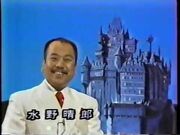
水野晴郎・映画解説 「カリオストロの城」
Renowned Japanese film critic Haruo Mizuno talking about Miyazaki's Cagliostro; the episode was dated 1980.
In his first director role, Miyazaki deploys numerous examples of his style to great effect. Dani Cavallaro highlights the signature details of Miyazaki's style and form being displayed in this work and how it impacts the portrayal of the story. Cagliostro, the country and setting, is depicted in meticulous detail and unconstrained by limitations of architecture, geography and culture, which can be described as akogare no Paris (Paris of our dreams), which is a fantastical view of Europe through Eastern eyes. The use of unexpected and unique camera angles and attention to individual movement of the characters are distinctive signatures of Miyazaki's style, including the opening heist scene which provides characterization and spirit to understanding the character of Lupin.
The changes made to the portrayal of the cast, depicting a heroic and selfless Lupin, a friendly Jigen, funny Goemon, and un-sexualized Fujiko, were initially not well received by fans. Otaku USA's Surat described compared this shift to "a James Bond movie where [James Bond] stayed at Motel 6 and his "Bond mobile" was a Toyota Camry!"
Release[]
The film's Japanese theatrical release was on 15 December 1979. A year later, Tokyo Movie Shinsha began screen testing the film in North America and it was notably shown at the World Science Fiction Convention in Boston for a marketing survey. It was later screened at other festivals during the 1980s, including FILMEX 82 in Los Angeles. Despite resounding acclaim from the screenings, many of them were unsuccessful. According to Fred Patten, the primary reason was that, "most people did not bother to come to it since it was "only" an animated-cartoon feature, not a "serious" live-action movie."
English Releases[]
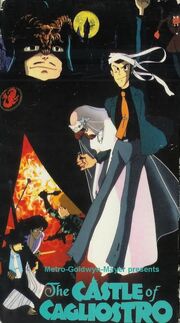
Metro-Goldwyn-Mayer's subtitled release of Lupin III: The Castle of Cagliostro.
The American theatrical debut was on 3 April 1991 in New York City by Carl Macek's Streamline Pictures, with the home release following in October 1992. Streamline's dub contains several deviations from the original Japanese script. Due to copyright issues with Maurice LeBlanc's estate, Lupin is referred to as "the Wolf." Inspector Koichi Zenigata is erroneously named Keibu Zenigata, likely due to a translation error (keibu being the Japanese title for a police inspector). The UK release followed on 10 June 1996 by Manga Video. Optimum Releasing re-released Cagliostro in the UK after Manga Entertainment lost its license in the UK. The new DVD features an anamorphic widescreen print with the original Japanese audio track as well as the Streamline dub, both in stereo.
In 2000, Manga released the film on home video in the United States with a newly commissioned dub that adhered closer to the original script with the correct names restored. The DVD preserves the film in its original aspect ratio of 1.85:1 widescreen and is non-anamorphic. It additionally features remastered audio and picture, but contains no extras. The same company later released a new special edition DVD of Cagliostro in 2006. The disc is double-sided with the film on side A and the extras on side B. It includes a new digital transfer; Manga's English dub in 2.0 and 5.1 surround plus Japanese, Spanish, and French language tracks in mono; the complete film in storyboard format, accompanied by Japanese audio with English subtitles; an original Japanese trailer; a sketch and still gallery; a 26-minute interview with animation director Yasuo Ōtsuka, and animated menus. The film is presented in 16:9 anamorphic widescreen; however, the opening credits have been heavily re-edited to remove the Japanese credits, instead using selected still-frames of scenes that appear without Japanese writing. The English-translated names are superimposed over these stills. This change was negatively received by fans of the film. Both DVD releases are out-of-print, with Manga no longer owning the U.S. film rights.

Comparison between the 1979 1st release & 2014 re-release Japanese B1 posters.
In December 2008, the film was released on Blu-ray in Japan. Its video format is MPEG-4 AVC and its digitally-remastered audio is improved over that of the DVD, but contains no English audio or subtitle options despite being in Region A format. Years later, a new HD digital remaster was produced and Cagliostro was given a limited theatrical re-release in Japan on 9 May 2014. The remaster was released both individually and as part of The Collected Works of Hayao Miyazaki, a box set containing all of Miyazaki's movies. Both these newer releases were released by Studio Ghibli in conjunction with Disney. StudioCanal released a Blu-ray and DVD bundle of the film on 12 November 2012 in the UK. The StudioCanal release is of superior quality with its new high definition transfer, but the credits for the film are absent.
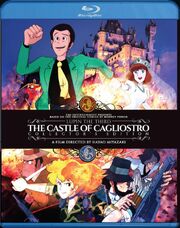
Diskotek Media's Blu-ray release.
North American anime distributor Discotek Media announced on 26 March 2014 that they had licensed the film and planned to release it on DVD in 2014, with a Blu-ray release to follow at a then-unspecified future date. The DVD version was eventually delayed to January 6, 2015 and included the Streamline and Animaze/Manga dubs, a "Family Friendly" alternate version of the Animaze/Manga dub with reduced profanity, the original Japanese audio with newly translated English subtitles, an alternate subtitle option based on the subtitles used by TMS in their 1980 screenings of the film, a collection of alternate opening and closing sequences to the film from previous releases, translation notes, two trailers and a fan-made audio commentary by Reed Nelson. The Blu-ray was released on 25 June 2015 and featured the same extras in addition to another alternate subtitle option using a literal translation of the film's screenplay, new interviews with David Hayter and Bob Bergen, an introduction to the film by Hayter, translated past interviews from the French Blu-ray (featuring Yasuo Ōtsuka, Kazuhide Tomonaga and Monkey Punch), an optional storyboard viewing mode, a slideshow gallery of production and promotional art, and a text-based overview of the film's production history. Plans to include an emulated port of Cliff Hanger as an extra feature for the Blu-ray were dropped when the original contracts for the game could not be found. The Castle of Cagliostro was included in Disney's The Collected Works of Hayao Miyazaki Blu-ray set released on November 17, 2015. This release features only the Streamline dub and the Japanese audio with English subtitles; none of the extras from Discotek's releases are included.
Reception[]
"95% of Lupin III fans outside Japan cite this work as what 'triggered them to become a fan.' I said, 'This is not my Lupin.' "It's a very good work by Miyazaki-kun, wrapped in kindness that I couldn't have drawn." But the second half of the caper was cut off, and only the first word was taken up. My Lupin is poisonous..."
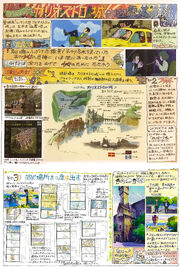
2015 comic by Hayao Miyazaki for the Welcome to the Ghost Tower Exhibition at the Ghibli Museum, featuring the lake divided by the Roman aqueduct, which connects the old castle with the clock tower.
While the film was not initially a box-office success, it gained popularity through numerous re-releases and was even voted as "the best anime in history" by the readers of Animage. Following a July 1992 release by Streamline Pictures, Janet Maslin said she thought the film "should fare nearly as well [as Akira] with animation fans of any age, provided they are unwavering in their devotion to the form and do not think 100 minutes is an awfully long time." According to Maslin, the film is an "interestingly wild hybrid of visual styles and cultural references" whose "animation is weak when it comes to fluid body movements, but outstanding in its attention to detail." According to Marc Savlov of The Austin Chronicle, "C of C refrains from the Technicolor ultra-violence that helped make films like Golgo 13, Akira, and Vampire Hunter D such audience favorites, and instead focuses on broad, almost slapstick humor and chaos to keep viewers riveted. Sometimes it works, and unfortunately, sometimes it doesn't." Review aggregator RottenTomatoes gives the film a 91% approval rating based on reviews from 11 critics, with an average rating of 7/10. Some fans maintain that it is not a "true" Lupin title, due to Miyazaki's altering of the titular character into a bumbling hero, rather than his original ruthless criminal self. Monkey Punch, creator of Lupin III, called Castle of Cagliostro an "excellent" movie, but agreed Miyazaki's vision of Lupin differs from his own. He said, "I wouldn't have had him rescue the girl, I would have had him rape her!"
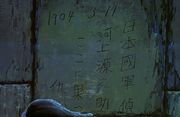
Underneath the castle contains a note, "1904.3.14 Gennosuke Kawakami, a Japanese military detective". This detail indicates how Japan once sent an agent named Kawakami to root out the secret of the Cagliostro Castle.
In Dani Cavallaro's The Anime Art of Hayao Miyazaki, the film was said to have received the "Award for Best Animated Feature". The actual award was from the 1979 Mainichi Film Concours, where the film received the Ōfuji Noburō Award. No concrete evidence for this claim has even been put forward and the misinformation in the releases serves to cement its decades-long persistence.
The film was the best selling anime DVD in May 2001, and the third best selling in June. Both of Manga Entertainment's releases of The Castle of Cagliostro received DVD Talk Collector Series recommendation status, the highest status given by the review website DVDtalk.com. Chris Beveridge of AnimeOnDVD.com gave the film a grade of "A+", although he disliked Manga Entertainment's use of PG-13 level language in the English dub. The Castle of Cagliostro placed in 5th place on Japan's Agency for Cultural Affairs's list of best anime.
Influences[]
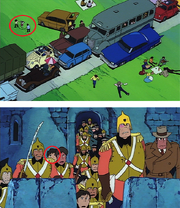
Mimiko from Panda! Go, Panda! and Conan from Future Boy Conan make cameo appearances in the film.
The film has itself been an influence in a range of other productions. In the early 80's, Hayao Miyazaki and several prominent Japanese animators were flown into the United States to promote the film and to learn animation from Disney's infamous Nine Old Men. "The Castle of Cagliostro" had been screening throughout California, and one of the attendees was director Steven Spielberg. He was so impressed with the film that it later influenced the action sequences in his Indiana Jones films and The Adventures of Tintin: The Secret of the Unicorn. Manga Entertainment's DVD release quotes him saying: "one of the greatest adventure movies of all time." An unverified statement has Spielberg calling the film's car chase "one of the greatest chase sequences ever filmed".
The character of Clarisse has also been cited as a potential ancestral example of moe character design, a trend Miyazaki would later criticize as leading to the promotion of unhealthy lolicon fetishism. In 1983, TMS with Stern Electronics wanted to capitalize on the success of animated Laserdisc video games at the time. They released the arcade game, Cliff Hanger, which used footage from this film, along with the previous Lupin film The Mystery of Mamo. Even though the films themselves weren't available in North America at the time, the Cliff Hanger game was featured in an episode of the game show Starcade.
Cagliostro deeply influenced Pixar co-founder John Lasseter, along with Miyazaki's later films; in October 2014, Lasseter delivered a keynote address to the Tokyo International Film Festival describing how Miyazaki's influence upon his own life and work began when he first saw a clip from Cagliostro. Walt Disney Animation Studios' 1986 film The Great Mouse Detective, co-directed by John Musker and Ron Clements, paid homage to Cagliostro with the film's climactic Big Ben sequence. Another reference to the clock-tower fight is in The Clock King episode of Batman: The Animated Series. Gary Trousdale, co-director of Disney's Atlantis: The Lost Empire, admitted that a scene at the end of Atlantis, where the waters recede from the sunken city, was directly inspired from the ending in Cagliostro. One of the sequence directors of The Simpsons Movie also mentioned Cagliostro as an influence; a brief shot where Bart Simpson rolls down the roof of the family house was inspired by Lupin running down the castle roof during his rescue attempt.
Cast[]
| Character | Original | Streamline dub | Manga dub |
|---|---|---|---|
| Arsene Lupin III | Yasuo Yamada | Bob Bergen | Sean Barker |
| Fujiko Mine | Eiko Masuyama | Edie Mirman | Dorothy Melendrez |
| Daisuke Jigen | Kiyoshi Kobayashi | Steve Bulen | Ivan Buckley |
| Goemon Ishikawa XIII | Makio Inoue | Steve Kramer | Marlon Mann |
| Koichi Zenigata | Goro Naya | David Povall | Dougary Grant |
| Clarisse d'Cagliostro | Sumi Shimamoto | Joan-Carol O'Connell | Rudy Marlowe |
| Barbara Goodson (young) | |||
| Count Cagliostro | Tarō Ishida | Michael McConnohie | Sparky Thornton |
| Gardener | Kōhei Miyauchi | Mike Reynolds | Gil Starberry |
| Jodo | Ichiro Nagai | Jeff Winkless | Richard Barnes |
| Kerrigan Mahan (three loops) | |||
| Gustav | Tadamichi Tsuneizumi | Kirk Thornton | Joe Romersa |
| Archbishop | Kinzô Azusa | Alfred Thor | |
| Interpol Secretary General | Shôzô Hirabayashi | Jeff Winkless | G. Gordon Baer |
| Servant 2 | Minoru Midorikawa | Carl Macek | Abe Lasser |
| Archbishop's Driver | Eken Mine | Steve Apostolina | Jeff Nimoy |
| Waitress | Yoko Yamaoka | Juliana Donald | Bambi Darro |
| Japanese Delegate | Akio Nojima | Kerrigan Mahan | Kenji Nakamura |
| American Councilman | Minoru Midorikawa | Tom Wyner | Wayne Anthony |
| Russian Councilman | Junkichi Yarita | Dougary Grant |
Additional Voices[]
- Original: Eken Mine (Riot Squad Member, Drunk Tourist), Mikio Terashima (West German Delegate), Osamu Saka (British Delegate), Junkichi Kamada (Soviet Delegate), Masayuki Katô (Printing Chief), Juji Matsuda (Saitama Police Riot Squad Leader)
- Streamline dub: Steve Apostolina (Interpol Officer 2), Bob Bergen (Ring Voice), Steve Bulen (Mustached Councilman, Italian Councilman), Barbara Goodson (Woman Playing Cards), Steve Kramer (Servant 1), Kerrigan Mahan (French Delegate, Goemon's Final Opponent, Patron), Mike Reynolds (German Councilman), Tom Wyner (Counterfeiter, Man Playing Cards, British Councilman)
- Manga dub: Wayne Anthony (Zenigata's Subordinate), Sentil Astoroth, Lauren Benjamin, Fred Bloggs (Counterfeiter, Whispering Councilman), Ivan Buckley, Susan Chavez, George C. Cole (French Delegate), Christopher Cunnington, John Daniels (Casino Police), Bambi Darro (Woman Playing Cards), Andrew Ebert, Gloria Gines, Kevin Guy, Jack Hamer, David Jeffries, Abe Lasser (Mustached Councilman), James Lyon, Jeff Nimoy (Italian Councilman, Restaurant Patron), Richard Plantagenet, Elliot Reynolds, Adam Sholder, Carol Stanzione, B.D. Vesbite, Keith R. Washington, David Waterhouse, Ken Zhee
Uncredited[]
- Carl Macek (Interpol Officer 1)
Credits[]
| Credit | Staff |
|---|---|
| Director | Hayao Miyazaki |
| Screenplay | Haruya Yamazaki, Hayao Miyazaki |
| Character Designer | Hayao Miyazaki, Yasuo Ōtsuka |
| Animation Director | Yasuo Ōtsuka |
| Assistant Director | Shigetsugu Yoshida |
| Key Animation | Atsuko Tanaka, Hideo Kawauchi, Johji Manabe, Kazuhide Tomonaga, Koichi Maruyama, Masako Shinohara, Nobumasa Shinkawa, Nobuo Tomizawa, Shojuro Yamauchi, Tsukasa Tannai |
| In-between Animation | Akihiro Shida, Atsuko Tanabe, Harumi Shibata, Hideyo Sano, Hitoshi Nanba, Junko Kojima, Junko Shimozaki, Junko Tsutsumi, Kaoru Honda, Kazuko Fujimura, Keiko Shimazu, Kumiko Hirama, Kyoko Kawanaka, Masako Hayashi, Masami Ozaki, Masanori Ono, Masayo Hamahata, Miwako Ohsato, Miwako Takagi, Rieko Mochizuki, Ryoko Kashiwada, Saburo Hashimoto, Sachiko Hamada, Shunsuke Harada, Toshiyuki Hiruma, Yasunao Aoki, Yayoi Kobayashi, Yoko Sakurai, Yoko Tsukada, Yoko Yoshimura, Yoshinobu Michihata, Yoshiyuki Hiruma, Yukio Suzuki, Yumiko Kumamoto |
| Background Artists | Hiromasa Ogura, Jinzaburo Kaiho, Katsushi Aoki, Koji Ono, Miyuki Kudo, Nizo Yamamoto, Satoshi Matsuoka, Toshiharu Mizutani, Tsutomu Ishigaki, Yuko Fujie, Yumiko Hayashi |
| Camera | Akio Hirayama, Katsumi Ota, Keizo Saito, Masao Miyauchi, Nobuhisa Takahashi, Tadashi Hosono, Takuo Sukuki, Yoshinori Nakamura |
| Music Coordination | Seiji Suzuki |
| Art Director | Shichirō Kobayashi |
| Negative Editing | Kazuko Takahashi |
| Producer | Tetsuo Katayama |
| Music | Yuji Ohno |
| Production Assistant | Kazuhiko Yagiuchi, Mikihiro Iwata, Rikio Yoshida |
References[]
External links[]
Official Sites
- The Castle of Cagliostro Official Website
Information
 The Castle of Cagliostro at the Internet Movie Database
The Castle of Cagliostro at the Internet Movie Database - The Castle of Cagliostro on Wikipedia
[]
| |||||||||||||||||||
